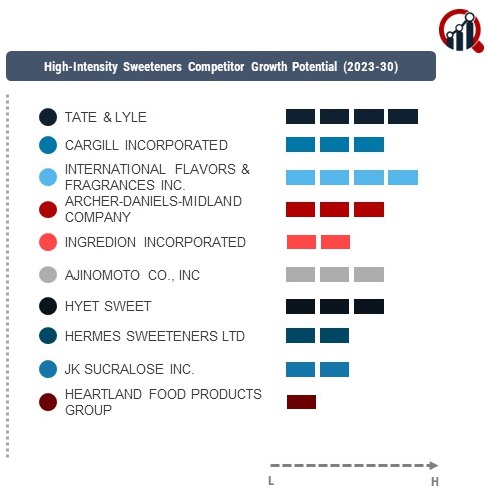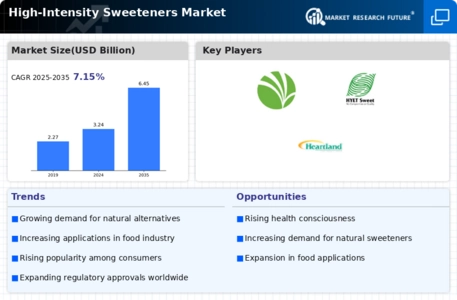Top Industry Leaders in the High-Intensity Sweeteners Market

Strategies Adopted by High-Intensity Sweeteners Key Players
The competitive landscape of the high-intensity sweeteners market is characterized by key players that play a pivotal role in the production, distribution, and innovation of sugar substitutes. As of 2023, major companies influencing this market include Tate & Lyle PLC, Ingredion Incorporated, Archer Daniels Midland Company, Ajinomoto Co., Inc., and Cargill, Incorporated.
Key Players:
Tate & Lyle (UK)
Cargill Incorporated (US)
International Flavors & Fragrances Inc. (US)
ADM (Archer Daniels Midland Company) (US)
Ingredion Incorporated (US)
Ajinomoto Co., Inc (US)
HYET Sweet (Netherlands)
Hermes Sweeteners Ltd (Switzerland)
JK Sucralose Inc. (China)
Heartland Food Products Group (US)
The high-intensity sweeteners market revolve around product innovation, strategic collaborations, market expansion, and sustainability. Product innovation is a key driver, with companies investing in the development of new high-intensity sweeteners, improving taste profiles, and addressing consumer concerns related to health and wellness. Strategic collaborations with food and beverage manufacturers, research institutions, and regulatory bodies facilitate the integration of high-intensity sweeteners into various applications and ensure compliance with industry standards. Market expansion efforts involve entering new geographic markets, adapting products to regional preferences, and forming strategic alliances to address the increasing global demand for sugar alternatives. Sustainability initiatives focus on responsible sourcing of raw materials, eco-friendly production processes, and reducing the environmental impact of high-intensity sweeteners.
Market Share Analysis:
The high-intensity sweeteners market include regulatory compliance, product quality, pricing strategies, brand reputation, and distribution networks. Regulatory compliance is crucial, with companies ensuring that their high-intensity sweeteners meet safety and quality standards set by regulatory authorities worldwide. Product quality, in terms of taste, stability, and purity, is a determining factor for consumer acceptance and loyalty. Pricing strategies, whether positioned competitively or as premium products, impact market share by appealing to specific consumer segments. Brand reputation plays a significant role, with well-established brands often enjoying preference in the market. Efficient distribution networks, including partnerships with food manufacturers and retailers, contribute to market reach and accessibility.
News & Emerging Companies:
The high-intensity sweeteners market has seen the emergence of new companies and trends responding to the growing demand for reduced-calorie sweetening solutions. Emerging companies often focus on natural sweeteners, such as steviol glycosides from stevia or monk fruit extract, to cater to consumer preferences for clean label and natural ingredients. Additionally, advancements in formulation technologies and the use of proprietary blends have gained traction among emerging players seeking to improve the taste and functionality of high-intensity sweeteners.
Industry Trends:
Industry trends in the high-intensity sweeteners market highlight ongoing research, partnerships, and a focus on consumer education. Many companies are investing in research and development to explore new sweetening solutions, address taste challenges, and expand the applications of high-intensity sweeteners. Partnerships with food and beverage manufacturers involve joint ventures, licensing agreements, and collaborations to integrate high-intensity sweeteners into a wider range of products. Consumer education efforts focus on dispelling myths, communicating the benefits of reduced-calorie sweeteners, and addressing concerns related to safety and taste.
Competitive Scenario:
The high-intensity sweeteners market remains dynamic, with established players adapting to changing consumer preferences and emerging companies contributing to innovation. Market dynamics are influenced by factors such as health and wellness trends, regulatory developments, and the increasing demand for reduced-sugar and reduced-calorie products. The resilience of the market is evident in its ability to evolve in response to consumer demand for healthier food and beverage options.
Recent Development
High-intensity sweeteners market presents a competitive landscape shaped by key players employing diverse strategies to meet the evolving demands of consumers. The emphasis on product innovation, strategic collaborations, market expansion, and sustainability underscores the industry's commitment to addressing changing market dynamics. As the market continues to evolve, companies that can balance taste, functionality, and sustainability are likely to maintain a competitive edge in the dynamic landscape of the high-intensity sweeteners market.

- Beta
Beta feature

